Understanding the Design and Application of Ring Joint Flanges in Industry
The Importance of Ring Joint Flanges in Industrial Applications
In the world of engineering and manufacturing, the importance of reliable connections cannot be overstated. One of the critical components that facilitate these connections in piping systems, especially in high-pressure applications, is the ring joint flange. This type of flange is specifically designed to provide a robust seal and withstand extreme conditions, making it indispensable in industries such as oil and gas, chemical processing, and power generation.
What is a Ring Joint Flange?
A ring joint flange is a type of flange that features a groove where a metal ring, known as a ring joint gasket, is placed. The flange itself is typically made of high-strength materials such as carbon steel, alloy steel, or stainless steel, chosen for their ability to resist corrosion and high temperatures. The unique design of ring joint flanges ensures that when tightened together with bolts, the gasket is compressed, creating a leak-proof seal.
Advantages of Ring Joint Flanges
One of the primary advantages of ring joint flanges is their ability to sustain high pressure and temperature conditions. They are engineered to perform reliably in environments where other types of gaskets may fail, making them ideal for applications in the oil and gas industry, where pressure can exceed thousands of psi. This resilience reduces the potential for leaks, which can lead to catastrophic failures and environmental hazards.
Another significant benefit of ring joint flanges is their ease of installation and maintenance
. The design allows for a straightforward alignment between the connecting pipes, and the standardization of sizes means they can be easily replaced or repaired. Additionally, they can handle thermal expansion and contraction better than many other flange types, contributing to their longevity and reducing the need for frequent maintenance.Applications in Various Industries
Ring joint flanges are widely used in a variety of industrial applications. In the oil and gas industry, for instance, they are essential in pipelines, refineries, and wellhead connections. The high-pressure demands of these environments make the reliability of these flanges critical for operational safety.
In the chemical processing sector, ring joint flanges play a vital role in transporting corrosive liquids and gases. The ability to withstand harsh chemicals while maintaining a secure seal is crucial for preventing leaks that could cause safety hazards or environmental contamination.
ring joint flange

Furthermore, ring joint flanges are commonly used in power plants, particularly in the steam lines where high temperatures and pressures are commonplace. The robust sealing capacities of these flanges ensure that the systems function efficiently without the risk of failures due to leakage.
Standards and Specifications
To ensure quality and compatibility, ring joint flanges are manufactured according to various industry standards, such as ASME (American Society of Mechanical Engineers) and API (American Petroleum Institute). These standards define the dimensions, material specifications, and testing methods required for safe and reliable performance.
Compliance with these standards not only guarantees the integrity of the flanges but also ensures interoperability among systems. This is particularly important in large-scale projects where different components from various manufacturers need to work together seamlessly.
Future Considerations
As industries evolve and prioritize sustainability, the design and manufacturing of ring joint flanges are also adapting. Innovations are focusing on materials that not only provide excellent sealing properties but also have a reduced environmental impact. The shift towards using more sustainable materials and production processes could lead to the development of even more efficient ring joint flanges in the future.
Additionally, advancements in technology, such as computer-aided design and simulation, enable engineers to create better-performing flanges tailored to specific applications. This evolution will likely further enhance the reliability and safety of industrial piping systems.
Conclusion
In conclusion, ring joint flanges are integral components in various industrial applications, providing essential sealing capabilities in high-pressure environments. Their durability, ease of installation, and robustness elevate their status as a preferred choice among engineers. As industries continue to seek innovative solutions for demanding applications, the ring joint flange will undoubtedly remain a pivotal element of safe and efficient operations in the engineering landscape.
-
Breakthrough in Domestic Low Temperature Valve Technology in ChinaNewsAug.18,2025
-
From Machinery to Intelligent Brain: The Digital Transformation Wave of the Valve IndustryNewsAug.18,2025
-
PCVEXPO 2025NewsAug.18,2025
-
The Key to Fluid Control: Exploring the Advantages of Ball Valves in Industrial SystemsNewsJul.09,2025
-
The Versatile World of 1, 2, and 3 Piece Ball ValvesNewsJul.09,2025
-
Stainless Steel Ball Valves: The Ideal Choice for Efficient Flow ControlNewsJul.09,2025
-
Optimizing Fluid Control with Ball Float ValvesNewsJul.09,2025




